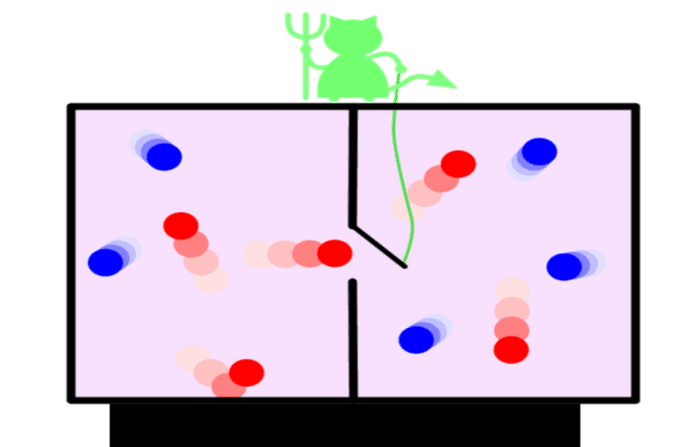Maxwell’s “demon” hypothesis, a theoretical entity capable of defying the laws of thermodynamics, finds unexpected resonance in modern biology. Recent research has identified cellular proteins acting similarly to this demon. The presence of these proteins in most organisms thus calls into question our current knowledge of thermodynamics and could influence future therapeutic approaches in medicine.
Thermodynamics is a fundamental pillar of physics, defining some of the important laws governing the universe . The laws of thermodynamics have long been considered unshakeable. In the middle of the 19th century, a hypothesis formulated by the physicist James Clerk Maxwell aroused particular curiosity. It suggests an entity capable of contradicting these principles. This “demon”, as he called it, would operate a door between two gas canisters, allowing one to become hotter than the other.
Physicist James Clerk Maxwell imagined a scenario in 1867 that seemed to violate the second law of thermodynamics, which states that heat always flows from warmer to colder objects unless some energy source reverses this trend. He envisioned a tiny door between two gas-filled chambers, controlled by a small demon. The demon would only allow faster-moving particles to enter one chamber and slower ones to enter the other, creating a temperature difference between the chambers. This would imply that you could extract energy from nothing by using the heat difference, breaking the second law.
This apparent contradiction was resolved in the 20th century, when information theorists like Rolf Landauer realized that the demon would need to gather information about each gas particle, store it in its memory and erase its memory for further measurements. This would consume more energy than the demon could generate by maintaining the heat difference of the chambers.
In nature, there are many systems that are not in equilibrium, similar to the warm and cold chambers, such as the different amounts of various molecules inside and outside living cells. Physicists have long wondered if something like Maxwell’s demon might be involved in these systems — but they couldn’t prove it mathematically.
Now, Paolo De Los Rios at the Swiss Federal Institute of Technology in Lausanne and his colleagues have demonstrated that ABC transporters – tiny proteins that can move molecules across a cell membrane – behave exactly like the demons proposed in Maxwell’s original scenario.
“Nature already figured out the rules billions of years ago,” says De Los Rios. “ABC transporters are present in all bacteria. They are very, very old. They go back to the last universal common ancestor of all life on Earth.”
De Los Rios and his team first wrote down simple equations describing how ABC transporters keep different amounts of molecules inside and outside of a cell. They took into account basic facts about how they work – such as using ATP, a molecular source of energy, to transport molecules across the membrane, and the different shapes the transporters can take when facing inside or outside the cell.
To act as Maxwell’s demon without violating the laws of thermodynamics, Landauer theorized that an entity needs to use energy, make recorded measurements and operate the door based on these measurements. De Los Rios and his colleagues found that the solution to their equations had three parts that matched these three conditions. “When you try to understand what these different terms mean, you actually recognize the building blocks of a Maxwell’s demon,” says De Los Rios.
There are some simplifications that they made to their model, such as assuming that each ABC transporter only uses one molecule of ATP at a time, but De Los Rios says that more complex models should also work as Maxwell’s demons. He also says that, given the similar functions and roles that many molecular machines play, it is likely that Maxwell’s demon is common in nature.
“They make very clear connections between the rigorous idea of Maxwell’s demon as it is now understood in statistical physics and the way these ABC transporters work,” says Nahuel Freitas at the University of Buenos Aires in Argentina. “They go beyond the level of a metaphor.”
This connection also means that an ABC transporter can be considered as a simple computational device, performing the same logical “AND” operation that silicon computer chips do, says Freitas.
Reference:
Flatt, S., Busiello, D.M., Zamuner, S. et al. ABC transporters are billion-year-old Maxwell Demons. Commun Phys 6, 205 (2023). DOI: 10.1038/s42005-023-01320-y
